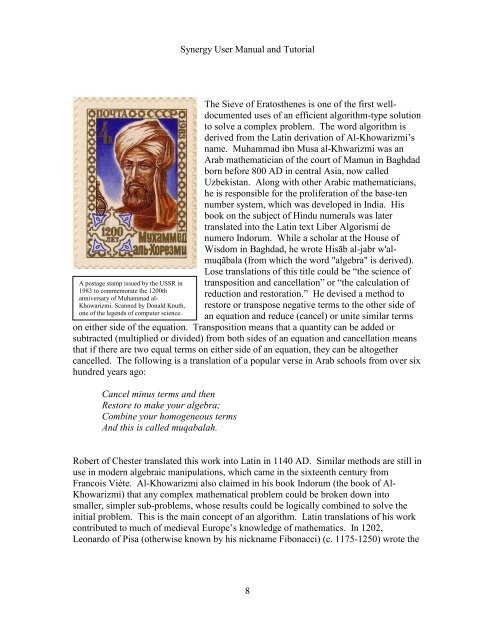Synergy User Manual and Tutorial. - THE CORE MEMORY
Synergy User Manual and Tutorial. - THE CORE MEMORY
Synergy User Manual and Tutorial. - THE CORE MEMORY
Create successful ePaper yourself
Turn your PDF publications into a flip-book with our unique Google optimized e-Paper software.
<strong>Synergy</strong> <strong>User</strong> <strong>Manual</strong> <strong>and</strong> <strong>Tutorial</strong><br />
A postage stamp issued by the USSR in<br />
1983 to commemorate the 1200th<br />
anniversary of Muhammad al-<br />
Khowarizmi. Scanned by Donald Knuth,<br />
one of the legends of computer science.<br />
The Sieve of Eratosthenes is one of the first welldocumented<br />
uses of an efficient algorithm-type solution<br />
to solve a complex problem. The word algorithm is<br />
derived from the Latin derivation of Al-Khowarizmi’s<br />
name. Muhammad ibn Musa al-Khwarizmi was an<br />
Arab mathematician of the court of Mamun in Baghdad<br />
born before 800 AD in central Asia, now called<br />
Uzbekistan. Along with other Arabic mathematicians,<br />
he is responsible for the proliferation of the base-ten<br />
number system, which was developed in India. His<br />
book on the subject of Hindu numerals was later<br />
translated into the Latin text Liber Algorismi de<br />
numero Indorum. While a scholar at the House of<br />
Wisdom in Baghdad, he wrote Hisãb al-jabr w'almuqãbala<br />
(from which the word "algebra" is derived).<br />
Lose translations of this title could be “the science of<br />
transposition <strong>and</strong> cancellation” or “the calculation of<br />
reduction <strong>and</strong> restoration.” He devised a method to<br />
restore or transpose negative terms to the other side of<br />
an equation <strong>and</strong> reduce (cancel) or unite similar terms<br />
on either side of the equation. Transposition means that a quantity can be added or<br />
subtracted (multiplied or divided) from both sides of an equation <strong>and</strong> cancellation means<br />
that if there are two equal terms on either side of an equation, they can be altogether<br />
cancelled. The following is a translation of a popular verse in Arab schools from over six<br />
hundred years ago:<br />
Cancel minus terms <strong>and</strong> then<br />
Restore to make your algebra;<br />
Combine your homogeneous terms<br />
And this is called muqabalah.<br />
Robert of Chester translated this work into Latin in 1140 AD. Similar methods are still in<br />
use in modern algebraic manipulations, which came in the sixteenth century from<br />
Francois Viète. Al-Khowarizmi also claimed in his book Indorum (the book of Al-<br />
Khowarizmi) that any complex mathematical problem could be broken down into<br />
smaller, simpler sub-problems, whose results could be logically combined to solve the<br />
initial problem. This is the main concept of an algorithm. Latin translations of his work<br />
contributed to much of medieval Europe’s knowledge of mathematics. In 1202,<br />
Leonardo of Pisa (otherwise known by his nickname Fibonacci) (c. 1175-1250) wrote the<br />
8

















